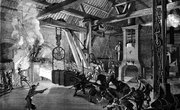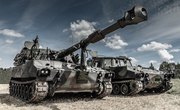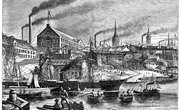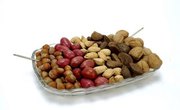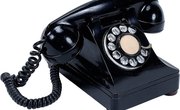The 1950s heralded a new era of technological advances that promised increased efficiency and labor-saving features in common household appliances. As the demand for consumer goods increased toward the end of World War II, advertising campaigns targeted the growing middle class family that resulted from the post-war housing boom. "New and improved" electric appliances allowed American households to upgrade their standards of living and streamline domestic chores. These appliances also gave housewives more leisure time to participate in social activities and cultivate family values.
Modern Convenience
Traditional media encouraged the growth of modern convenience through the use of household appliances. The allure of performing common maintenance tasks such as cleaning, cooking and storing food at the touch of a button appealed greatly to American households in the 1950s. American spending on household goods increased by 240 percent as electrical appliance manufacturers cranked out new innovations and enhanced current appliances such as refrigerators, vacuum cleaners, electric ovens, televisions and radios. This demand fueled a growth in manufacturing that led to revolutionary advances in appliance technology.
The Rise of the Efficient Kitchen
By 1955, 80 percent of American homes owned a refrigerator that was not only more energy efficient, but came with automatic defrost and ice-maker capabilities. Electric ovens and stovetops, or ranges, were often combined into one unit and incorporated seamlessly into kitchen countertops. Dishwashers, once a luxury item, became more commonplace as redesigned kitchens included increasingly advanced and affordable technology. Smaller electrical appliances such as toasters, mixers, juicers and can openers made an extraordinary appearance and gained in popularity for their efficiency in cutting down time and effort in food preparation.
Laundry Appliances
Improvements in clothes washing appliances led to a greater variety in automated units that could be operated with simple controls. Combination washer/dryers, automated top-loaders, front-loading dryers, and electric irons soon became essential laundry room additions. The average washer and dryer unit cost approximately $600 during the 1950s.
"Combination" Products
Appliance manufacturers of the 1950s combined desirable features into one efficient product. Some of these products include washer and dryer units, radio-phonograph consoles, TV-phone devices and refrigerator-stove combinations and mobile garbage burners. Mobility and compactness became selling points to a public that was increasingly concerned with reducing the drudgery of household tasks.
Other Appliances
- Air Conditioning Units: Although introduced in the 1930s, portable air conditioner units became increasingly more popular in the 1950s as the window unit was introduced.
- Televisions: The 1950s has often been called the Golden Age of television. During this period, the number of TVs in American households rose from 1 million to 88 million, and they accounted for almost 97 percent of all households towards the end of the era.
- Space Heaters: Space heaters replaced oil burning and coal fires and could be used wherever an electric outlet was available. Compact and mobile, these appliances increased comfort inside modern homes.
Related Articles
References
Writer Bio
Tanya Soraya Ruys is a published author who writes about home improvement, interior design, alternative medicine, culture, film and social media. She is currently working on her master's thesis in film and creative writing at Sonoma State University in Rohnert Park, Calif.



